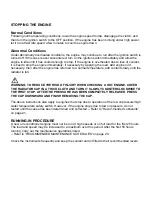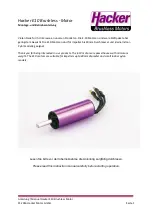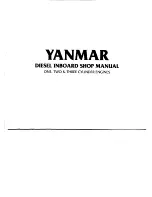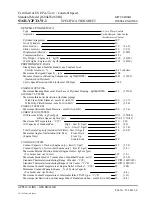
1. Auxiliary Circuits - When moved to this position the auxiliary electrical equipment such as
radios and heater fans, can be operated without also connecting the starting circuit with the
battery.
2. Off - When set to this position, the switch disconnects the auxiliary electrical equipment and
the starting circuit from the battery. The key can be removed from the switch when it is in
this position; this will help to prevent unauthorized operation of the engine.
3. Run - This switch position connects the auxiliary circuits as described previously, and the
alternator is given initial excitation via the battery.
4. Start - In this position, the starter solenoid is energized and the starter motor cranks the
engine. The switch, when released, automatically returns to the RUN position.
Safety Switch (where fitted)
A low oil pressure/high water temperature safety switch may be fitted. This automatically shuts off
the ignition when the oil pressure drops below a pre-set value, or when the water temperature rises
above a pre-set value. A button on the instrument panel is used to override the safety switch when
starting the engine. The safety switch override button must be depressed to start the engine.
NOTE:
With EDI GCP safety shut-down incorporated oil pressure below 6 psi and/ or coolant
temperature goes above 250° F, will shut-down ignition system. Corrective action must be taken
and key recycled to restart.
Power Take-off (where fitted)
The power take-off control handle allows engagement and disengagement of the power take-off
clutch. Moving the lever towards the engine engages the clutch and moving the lever away from
the engine disengages the clutch.
When moving the handle to engage the clutch and pick up the load, do so in a smooth manner.
Moving the clutch handle too slowly will cause slippage and wear, while moving it too fast will
cause quick engagement and possible damage to the power take-off, engine or driven equipment.
The normal force required to engage the clutch is 55 lbf (245 N) for the over-centre type and 25 lbf
(110 N) for the spring loaded type.
Throttle Control (where fitted)
The throttle control adjusts engine speed. Initial engine speed adjustment is obtained by pressing
the throttle control release button while pulling the throttle knob out to increase the engine speed or
pushing it in to decrease the engine speed. A final fine speed adjustment is obtained by turning the
throttle control counterclockwise to increase engine speed or clockwise to decrease engine speed.
Summary of Contents for wsg-1068
Page 2: ...ARNING ...
Page 33: ...Engine Performance While Under Load ...
Page 34: ......
Page 35: ...Engine Concerns ...
Page 36: ...SPECIFICATIONS ...
Page 37: ...TIGHTENING TORQUES ...
Page 38: ...CONVERSION TABLE ...
Page 39: ...EDI Distributors Europe ...
Page 40: ...New Zealand North America Canada ...
Page 41: ...North America United States ...
Page 42: ...North America United States Continued ...
Page 43: ......
Page 44: ......
Page 45: ......
Page 46: ......













































